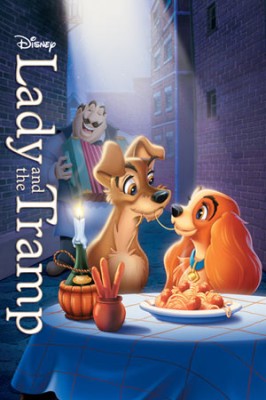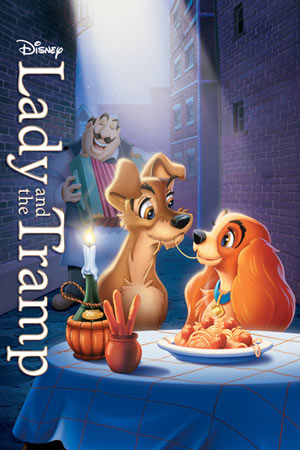
The 15th full-length animated feature in Disney history, Lady and the Tramp was theatrically released on June 22, 1955. It is based on Ward Greene’s short story “Happy Dan, The Whistling Dog” and is 75 minutes in length.
Plot Summary
The film commences with the Dear couple exchanging presents on a snowy Christmas morning. Darling, the wife, quickly falls in love with the puppy given to her by her husband, Jim, and after some minor difficulties on Christmas night, that puppy, Lady, becomes the Dears’ most prized possession.
Life for the clan chugs along well until the situation slowly deteriorates for Lady. You see, Darling is about to give birth, and Lady is scared that she will be forgotten.
As it turns out, the Dears still love Lady very much. This affection is, unfortunately, not shared by the house sitter, Aunt Sarah, who sees the dog as a nuisance. Sarah muzzles Lady, but the dog escapes and enjoys an evening on the town with another canine, the Tramp. While out, the duo engages in the ultimate romantic activity: eating a spaghetti dinner against the backdrop of instrumental music.
Lady and the Tramp appear to be in love despite decidedly different lifestyles and vocal opposition from Lady’s friends Trusty the bloodhound and Jock the Scottish terrier. Is the Tramp setting Lady up for heartbreak, or does he truly love her and have her best interests in mind?
Perspective and Villains
The story is told from a dog’s point of view. Especially in the first half of the movie, the faces of the Dears are rarely shown, and much of the dialogue concerns how humans impact dogs.
On a related note, there are no true villains in the film. Although Aunt Sarah is probably the film’s most unlikeable character because of her angry demeanor towards Lady, she doesn’t do anything outlandish per se. To me, Sarah’s actions are mainly infuriating because the film focuses on Lady. I feel the same way about other humans in the film such as the dog pound workers.
Themes
Though Lady and the Tramp emphasizes a canine perspective on the world, many of the film’s themes, including time, lifestyle differences, ideology, and redemption, are relatable to everyday life for humans.
In the early stages of the flick, Trusty says, “How time does fly!” in regards to Lady being six months old. It may just be me, but like Trusty, I am often caught off guard by the swift pace of life. It feels like I was in fourth grade just yesterday. Alas, that was in 1999.
The title characters lead vastly different lifestyles before meeting. Whereas Lady is cared for in a well-to-do household, the Tramp has to pursue food and shelter on the run; Lady has her own bowl and is treated to doughnuts from the breakfast table, while the Tramp begs for bones and quenches his thirst from public fountains.
It goes without saying that people disagree on politics and the state of life. These ideological differences are paralleled in the film through the Tramp’s debate with Trusty and Jock over whether humans really love dogs. Here, Jock derides the Tramp’s negative viewpoints, calling them “radical.”
Finally, as people often attempt to redeem themselves from past mistakes, so too does the Tramp. Towards the end of the film, the canine seeks to become more ethical. He wants Lady to trust him.
Humor
Much humor is inserted throughout the movie.
The segment where Lady repeatedly tries to escape her bed on Christmas night is entertaining and self-contained. Even without the film’s larger context, I think this scene would have made a good short.
Many of the dogs are amusing. Trusty has numerous funny lines, albeit these are a result of his deteriorating state, and so do the dogs at the pound. In particular, Boris sounds like John Locke with his knowledge of philosophy.
And let’s not forget the Tramp. As shown especially through the zoo sequence, he can impersonate and improvise with the best of them.
Action
Lady and the Tramp may be a romantic film at its core, but that doesn’t prohibit lots of action sequences from occurring.
Along the way, various dogs battle chickens, a rat, and the pound truck. We also see a fight between two humans at the zoo.
Music
The background music is well utilized to add suspense and drama when appropriate, and the soundtrack effectively complements the plot. I find the individual songs to be rather forgettable, however, perhaps because I prefer lyrical music. The music here is mainly instrumental.
Introduced during the opening credits and reprised during the spaghetti dinner, “Bella Notte” is probably the film’s most recognizable number. It is, in fact, beautiful.
“Peace on Earth” follows the opening credits. Coupled with images of snow, this song succeeds in creating a Christmas setting.
Sung by Aunt Sarah’s two cats, “The Siamese Cat Song” exudes a mysterious vibe with the two felines essentially emerging from nowhere to wreak havoc. It is…interesting, I guess. Actually, I find it bizarre.
Finally, I think the combination of “What is a Baby?” and “La La Lu” forms one of the film’s most heartwarming scenes. Here, an insecure Lady is reassured that she still holds a key place in the Dears’ hearts.
Relationship to Other Disney Films
As a stray, the Tramp reminds me of Thomas O’Malley, the alley cat from The Aristocats (1970).
Lady and the Tramp was the second straight Disney animated film to feature a Mrs. Darling, because Darling was also the last name of the family in Peter Pan (1953). So, it was Mrs. Darling in Peter Pan and Mrs. Darling Dear in Lady and the Tramp.
Anyway, I’m getting myself confused, so let’s move on.
In the Parks
Walt Disney World’s Magic Kingdom is home to “Tony’s Town Square Restaurant.” Named after the Italian eatery from the movie, this full-service restaurant sports Lady and the Tramp theming. ADRs are recommended.
Additionally, Disneyland Park Paris features “Pizzeria Bella Notte” in its Fantasyland. This counter-service restaurant, which is named after the song “Bella Notte” from the film, is also themed after the flick.
Overall
Lady and the Tramp successfully combines a plethora of elements to form a Disney classic. It is definitely worth watching, with or without a plate of spaghetti and meatballs.
What do you think of Lady and the Tramp? Let me know in a comment!
Sponsored Ad: Would you like to help support The Mouse For Less website in continuing their mission of being THE Disney vacation planning resource? You can do so by purchasing Lady and the Tramp from our affiliate link through Amazon.
Incoming search terms:
- https://www themouseforless com/blog_world/movie-review-lady-tramp/#:~:text=Lady and the Tramp was the second straight Disney animated in Peter Pan and Mrs
- https://www themouseforless com/blog_world/movie-review-lady-tramp/
- https://www themouseforless com/blog_world/movie-review-lady-tramp/#:~:text=Relationship to Other Disney Films&text=Lady and the Tramp was the second straight Disney animated in Peter Pan and Mrs
- https://www themouseforless com/blog_world/movie-review-lady-tramp/#:~:text=Though Lady and the Tramp to everyday life for humans
- https://www themouseforless com/blog_world/movie-review-lady-tramp/#:~:text=Lady and the Tramp was the second straight Disney animated in Peter Pan (1953)
- https://www themouseforless com/blog_world/movie-review-lady-tramp/#:~:text=Relationship to Other Disney Films&text=Darling, because Darling was also in Lady and the Tramp

